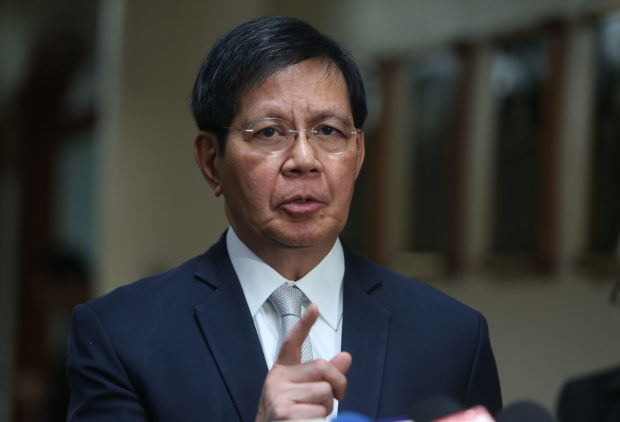Lacson flags discrepancy, ‘poor planning’ in DSWD’s ayuda distribution

Senator Ping Lacson answers questions from the media in this photo taken in October 2021 in the Senate. INQUIRER file photo / EDWIN BACASMAS
MANILA, Philippines — Senator Panfilo Lacson has flagged the discrepancy in the records of the Department of Social Welfare and Development (DSWD) regarding its distribution of Social Amelioration Program (SAP) aid to Filipinos.
Lacson was puzzled as to how the DSWD could claim a 94-percent physical accomplishment of its distribution of SAP aid when its own record showed it had disbursed only 80 percent of the funds.
“Something doesn’t add up,” the senator said as he interpellated the DSWD on its proposed P191.4-billion budget for 2022 on Monday.
Citing latest data submitted by the DSWD to the Senate, Lacson noted that the agency was able to distribute SAP aid to 717,372 out of its 761,259 target beneficiary families or a 94.23-percent accomplishment.
“Hindi ko ito ma-reconcile doon sa 80.48 percent na obligation rate. Paanong nangyari na ang physical accomplishment under Bayanihan 2 nasa 94 plus percent na samantalang yung disbursement over obligation 99 percent of 80.48 percent,” he added.
(I can’t reconcile this with the 80.48-percent obligation rate. How did you record 94 plus percent of physical accomplishment under Bayanihan 2 when the disbursement over obligation is 99 percent of 80.48 percent.)
“So papaano natin ito mare-reconcile na yung physical accomplishment napakataas samantalang yung obligation or disbursement rate, napakababa?” he asked.
(So how can we reconcile the high physical accomplishment with the low obligation or disbursement rate?)
In response, DSWD Assistant Bureau Director Hannah Carcido told senators that the agency adjusted its target to 761,259, noting that its target was originally 855,597 beneficiaries.
“On the Bayanihan 2 po, we adjusted our targets to consider yung granular lockdowns. We only targeted the actual names submitted by the local government units (LGUs) and supported by the necessary certification from the local IATF (Inter-Agency Task Force). Kaya po yung aming physical targets sa Bayanihan 2 corresponds to the actual names submitted to us by the LGUs,” she explained.
Senator Imee Marcos, who led the DSWD’s budget hearing, asked the agency to revise its records.
“Because there’s a 14-percent differential,” she noted.
‘Poor planning’
Lacson, meanwhile, called out the DSWD over its “poor planning” when it engaged the services of financial service providers before learning that 70 percent of beneficiaries have no mobile phones or have defective mobile phones and are unable to receive cash assistance through digital distribution.
“The DSWD became reactive. It did not determine the beneficiaries’ capability to use mobile phones before distributing the aid, so it had to engage financial service providers,” he said.
“It should have planned first and determined the capability of the beneficiaries to receive aid via mobile phones. The bottom line is poor planning,” Lacson added.
Further, the senator also questioned the DSWD’s use of the 2015 census of the Philippine Statistics Authority in its list of SAP beneficiaries.
He said this prompted the local government units (LGUs) ran into problems distributing the SAP after complaints were lodged against them for not distributing the aid based on the DSWD’s data, which turned out to be “outdated.”
“Some barangay chairmen agreed among themselves to just redistribute the P5,000 to P8,000 accordingly because the list provided by the DSWD central office was outdated,” Lacson said.
“They wanted to adapt to the situation on the ground. We cannot fault the LGUs,” he added.
RELATED STORIES:
DILG to finish ‘ayuda’ distribution in Bataan this week
‘Ayuda’ distribution quicker but many still waiting